Grain Yield Potential of Intermediate Wheatgrass in Western Canada
Abstract
:1. Introduction
2. Materials and Methods
2.1. Experimental Locations
2.1.1. Experimental Design
2.1.2. Experimental Conditions
2.2. Measurements
2.2.1. Inflorescence Density (INFD)
2.2.2. Biomass at Stand Maturity (BIOM)
2.2.3. Grain Yield (GYLD)
2.2.4. Thousand Seed Weight (TSW) and Protein (GPROT)
2.2.5. Harvest Index (HI)
2.2.6. Path Analysis
2.3. Statistical Analysis
3. Results and Discussion
3.1. Grain Yield (GYLD)
3.1.1. Location Effects
3.1.2. Treatment Effects
3.2. Harvest Biomass (BIOM)
3.3. Harvest Index (HI)
3.4. Thousand Seed Weight (TSW)
3.5. Inflorescence Density (INFD)
3.6. Grain Protein (GPROT)
3.7. Path Analysis
3.8. Other Considerations
4. Conclusions
Author Contributions
Funding
Institutional Review Board Statement
Data Availability Statement
Acknowledgments
Conflicts of Interest
References
- Bajgain, P.; Zhang, X.; Jungers, J.M.; DeHaan, L.R.; Heim, B.; Sheaffer, C.C.; Wyse, D.L.; Anderson, J.A. ‘MN-clearwater’, the first food-grade intermediate wheatgrass (Kernza perennial grain) cultivar. J. Plant Regist. 2020, 14, 288–297. [Google Scholar] [CrossRef]
- Bajgain, P.; Crain, J.L.; Cattani, D.J.; Larson, S.R.; Altendorf, K.R.; Anderson, J.A.; Poland, A.; Westerbergh, T.E.; Crews, M.K.; Turner, Y.H.; et al. Breeding Intermediate Wheatgrass for Grain Production. Plant Breed. Rev. 2022, 46, 119–217. [Google Scholar]
- Cattani, D.J.; Asselin, S.R. Extending the Growing Season: Forage seed production and perennial grains. Can. J. Plant Sci. 2018, 98, 235–246. [Google Scholar] [CrossRef]
- Hunter, M.C.; Sheaffer, C.C.; Culman, S.W.; Lazarus, W.F.; Jungers, J.M. Effects of defoliation and row spacing on intermediate wheatgrass II: Forage yield and economics. Agron. J. 2020, 112, 1862–1880. [Google Scholar] [CrossRef]
- Crews, T.E.; Cattani, D.J. Strategies, Advances, and Challenges in Breeding Perennial Grain Crops. Sustainability 2018, 10, 2192. [Google Scholar] [CrossRef]
- Favre, J.R.; Castiblanco, T.M.; Combs, D.K.; Wattiaux, M.A.; Picasso, V.D. Forage nutritive value and predicted fiber digestibility of Kernza intermediate wheatgrass in monoculture and in mixture with red clover during the first production year. Anim. Feed. Sci. Technol. 2019, 258, 114298. [Google Scholar] [CrossRef]
- Crews, T.E. Closing the gap between grasslands and grain agriculture. Kans. J. Law Public Policy 2017, 26, 274–296. [Google Scholar]
- Duchene, O.; Celette, F.; Ryan, M.R.; DeHaan, L.R.; Crews, T.E.; David, C. Integrating multipurpose perennial grains crops in Western European farming systems. Agric. Ecosyst. Environ. 2019, 284, 106591. [Google Scholar] [CrossRef]
- Ashworth, A.J.; Katuwal, S.; Moore, P.A., Jr.; Adams, T.; Anderson, K.; Owens, P.R. Perenniality drives multifunctional forage-biomass filter strips’ ability ot improve water quality. Crop Sci. 2022, 63, 336–348. [Google Scholar] [CrossRef]
- Crews, T.E.; Carton, W.; Olsson, L. Is the future of agriculture perennial? Imperatives and opportunities to reinvent agriculture by shifting from annual monocultures to perennial polycultures. Glob. Sustain. 2018, 1, 1–18. [Google Scholar] [CrossRef]
- Meiss, H.; Médiène, S.; Waldhardt, R.; Caneill, J.; Munier-Jolain, N. Contrasting weed species composition in perennial alfalfas and six annual crops: Implications for integrated weed management. Agron. Sustain. Dev. 2010, 30, 657–666. [Google Scholar] [CrossRef]
- O’Mara, F.P. The role of grasslands in food security and climate change. Ann. Bot. 2012, 110, 1263–1270. [Google Scholar] [CrossRef]
- Crews, T.; Rumsey, B. What Agriculture Can Learn from Native Ecosystems in Building Soil Organic Matter: A Review. Sustainability 2017, 9, 578. [Google Scholar] [CrossRef]
- Zhang, S.; Huang, G.; Zhang, Y.; Lv, X.; Wan, K.; Liang, J.; Feng, Y.; Dao, J.; Wu, S.; Zhang, L.; et al. Sustained productivity and agronomic potential of perennial rice. Nat. Sustain. 2023, 6, 28–38. [Google Scholar] [CrossRef]
- DeHaan, L.; Christians, M.; Crain, J.; Poland, J. Development and Evolution of an Intermediate Wheatgrass Domestication Program. Sustainability 2018, 10, 1499. [Google Scholar] [CrossRef]
- Daly, E.J.; Hernandez-Ramirez, G.; Puurveen, D.; Ducholke, C.; Kim, K.; Oatway, L. Perennial rye as a rain crop in Alberta, Canada: Prospects and challenges. Agron. J. 2021, 114, 471–489. [Google Scholar] [CrossRef]
- Klitgaard, K. Sustainability as an Economic Issue: A BioPhysical Economic Perspective. Sustainability 2020, 12, 364. [Google Scholar] [CrossRef]
- Jungers, J.M.; DeHaan, L.R.; Betts, K.J.; Sheaffer, C.C.; Wyse, D.L. Intermediate wheatgrass grain and forage yield responses to nitrogen fertilization. Agron. J. 2017, 109, 462–472. [Google Scholar] [CrossRef]
- Reilly, E.C.; Gutknecht, J.L.; Tautges, N.E.; Sheaffer, C.C.; Jungers, J.M. Nitrogen transfer and yield effects of legumes intercropped with the perennial grain crop intermediate wheatgrass. Field Crops Res. 2022, 286, 108627. [Google Scholar] [CrossRef]
- Fagnant, L.; Duchêne, O.; Celette, F.; David, C.; Bindelle, J.; Dumont, B. Learning about the growing habits and reproductive strategy of Thinopyrum intermedium through the establishment of its critical nitrogen dilution curve. Field Crops Res. 2023, 291, 108802. [Google Scholar] [CrossRef]
- Mulla, D.J.; Tahir, M.; Jungers, J.M. Comparative simulation of crop productivity, soil moisture and nitrate-N leaching losses for intermediate wheatgrass and maize in Minnesota using the DSSAT model. Front. Sustain. Food Syst. 2023, 7, 1010383. [Google Scholar] [CrossRef]
- Tautges, N.E.; Jungers, J.M.; DeHaan, L.R.; Wyse, D.L.; Sheaffer, C.C. Maintaining grain yields of the perennial cereal intermediate wheatgrass in monoculture v. bi-culture with alfalfa in the Upper Midwestern USA. J. Agric. Sci. 2018, 156, 758–773. [Google Scholar] [CrossRef]
- Dick, C.; Cattani, D.; Entz, M.H. Kernza intermediate wheatgrass (Thinopyrum intermedium) grain production as influenced by legume intercropping and residue management. Can. J. Plant Sci. 2018, 98, 1376–1379. [Google Scholar] [CrossRef]
- Olugbenle, O.; Pinto, P.; Picasso, V.D. Optimal planting date of Kernza intermediate wheatgrass intercropped with Red Clover. Agronomy 2021, 11, 2227. [Google Scholar] [CrossRef]
- Aamlid, T. Primary and Secondary Induction Requirements for Flowering of Contrasting European Varieties of Lolium perenne. Ann. Bot. 2000, 86, 1087–1095. [Google Scholar] [CrossRef]
- Heide, O.M. Control of flowering and reproduction in temperate grasses. New Phytol. 1994, 128, 347–362. [Google Scholar] [CrossRef]
- Duchene, O.; Dumont, B.; Cattani, D.J.; Fagnant, L.; Schlautman, B.; DeHaan, L.R.; Barriball, S.; Jungers, J.M.; Picasso, V.D.; David, C.; et al. Phenological development of Thinopyrum intermedium highlights the importance of dual induction for reproductive growth and agronomic performance. Agric. For. Meteorol. 2021, 301–302, 108341. [Google Scholar] [CrossRef]
- Williamson, M.M.; Wilson, G.W.T.; Hartnett, D.C. Controls on bud activation and tiller initiation in C3 and C4 tallgrass prairie grasses: The role of light and nitrogen. Botany 2012, 90, 1221–1228. [Google Scholar] [CrossRef]
- Mitchell, R.B.; Moore, L.E.; Kenneth, J.; Redfearn, D.D. Tiller Demographics and Leaf Area Index of Four Perennial Pasture Grasses. Agron. J. 1998, 90, 47–53. [Google Scholar] [CrossRef]
- Crews, T.E.; Blesh, J.; Culman, S.W.; Hayes, R.C.; Jensen, E.S.; Mack, M.C.; Peoples, M.B.; Schipanski, M.E. Going where no grains have gone before: From early to mid-succession. Agric. Ecosyst. Environ. 2016, 223, 223–238. [Google Scholar] [CrossRef]
- Sylvester, A.W.; Reynolds, J.O. Annual and Biennial Flowering Habit of Kentucky Bluegrass Tillers. Crop Sci. 1999, 39, 500–508. [Google Scholar] [CrossRef]
- Jonsdottir, G.A. Tiller demography in seashore populations of Agrostis stolonifera, Festuca rubra and Poa irrigata. J. Veg. Sci. 1991, 2, 89–94. [Google Scholar] [CrossRef]
- Manitoba Agriculture, Food and Rural Initiatives (MAFRI). Soil Series Descriptions. Agriculture: Province of Manitoba. 2010. Available online: https://agrimaps.gov.mb.ca/agrimaps/extras/info/Soil_Series_Descriptions.pdf (accessed on 18 October 2022).
- Saskatchewan Soil Information System (SKSIS) Working Group; Bedard-Haughn, A.; Bentham, M.; Krug, P.; Walters, K.; Jamsrandorj, U.; Kiss, J. (Eds.) Saskatchewan Soil Information System—SKSIS; University of Saskatchewan: Saskatoon, SK, Canada, 2018; Available online: https://sksis.usask.ca (accessed on 18 October 2022).
- Cattani, D.J. Selection of a perennial grain for seed productivity across years: Intermediate wheatgrass as a test species. Can. J. Plant Sci. 2017, 97, 516–524. [Google Scholar] [CrossRef]
- Entz, M.H.; Smith, S.R., Jr.; Cattani, D.J.; Storgaard, A.K. Influence of post-harvest residue management on tiller dynamics and seed yield in timothy. Can. J. Plant Sci. 1994, 74, 507–513. [Google Scholar] [CrossRef]
- Cattani, D.J.; Smith, S.R., Jr.; Miller, P.R.; Feindel, D.E.; Gjuric, R. Seed yield of creeping bentgrass entries in Manitoba. Can. J. Plant Sci. 2004, 84, 117–124. [Google Scholar] [CrossRef]
- Gavloski, J. Cutworms in Field Crops. Agriculture: Province of Manitoba. 2019. Available online: https://www.gov.mb.ca/agriculture/crops/insects/cutworms-field-crops.html (accessed on 28 September 2022).
- Hendrickson, J.R.; Berdahl, J.D.; Liebig, M.A.; Karn, J.F. Tiller Persistence of eight intermediate wheatgrass entries grazed at three morphological stages. Agron. J. 2005, 97, 1390–1395. [Google Scholar] [CrossRef]
- Ivancic, K.; Locatelli, A.; Tracy, W.F.; Picasso, V. Kernza intermediate wheatgrass (Thinopyrum intermedium) response to a range of vernalization conditions. Can. J. Plant Sci. 2021, 101, 770–773. [Google Scholar] [CrossRef]
- Schipanski, M.E.; Barbercheck, M.E.; Murrell, E.G.; Harper, J.; Finney, D.M.; Kaye, J.P.; Mortensen, D.A.; Smith, R.G. Balancing multiple objectives in organic feed and forage cropping systems. Agric. Ecosyst. Environ. 2017, 239, 219–227. [Google Scholar] [CrossRef]
- Fernandez, C.W.; Ehlke, N.; Sheaffer, C.C.; Jungers, J.M. Effects of nitrogen fertilization and planting density on intermediate wheatgrass yield. Agron. J. 2020, 112, 4159–4170. [Google Scholar] [CrossRef]
- Kemp, D.R.; Culvenor, R.A. Improving the grazing and drought tolerance of temperate perennial grasses. N. Z. J. Agric. Res. 1994, 37, 365–378. [Google Scholar] [CrossRef]
- Frahm, C.S.; Tautges, N.E.; Jungers, J.M.; Ehlke, N.J.; Wyse, D.L.; Sheaffer, C.C. Responses of intermediate wheatgrass to plant growth regulators and nitrogen fertilizer. Agron. J. 2018, 110, 1028–1035. [Google Scholar] [CrossRef]
- Duchene, O.; Bathellier, C.; Dumont, B.; David, C.; Celette, F. Weed community shifts during the aging of perennial intermediate wheatgrass crops harvested for grain in arable fields. Eur. J. Agron. 2023, 143, 126721. [Google Scholar] [CrossRef]
- Wang, X.; Christensen, S.; Svensgaard, J.; Jensen, S.M.; Liu, F. The effects of cultivar, nitrogen supply and soil type on radiation use efficiency and harvest index in Spring Wheat. Agronomy 2020, 10, 1391. [Google Scholar] [CrossRef]
- Hussain, I.; Khan, M.A.; Khan, E.A. Bread wheat varieties as influenced by different nitrogen levels. J. Zhejiang Univ. Sci. B 2006, 7, 70–78. [Google Scholar] [CrossRef] [PubMed]
- Cookson, W.R.; Rowarth, J.S.; Cameron, K.C. The response of a perennial ryegrass (Lolium perenne L.) seed crop to nitrogen fertilizer application in the absence of moisture stress. Grass Forage Sci. 2000, 55, 314–325. [Google Scholar] [CrossRef]
- Cattani, D.J.; Asselin, S.R. Has selection for grain yield altered intermediate wheatgrass? Sustainability 2018, 10, 688. [Google Scholar] [CrossRef]
- Peterson, M.L.; Loomis, W.E. Effects of photoperiod and temperature on growth and flowering of Kentucky bluegrass. Plant Physiol. 1949, 24, 31–43. [Google Scholar] [CrossRef]
- Newell, L.C. Controlled life cycles of Bromegrass, Bromus inermis Leyss., used in improvement. Agron. J. 1951, 43, 417–424. [Google Scholar] [CrossRef]
- Calder, D.M.; Cooper, J.P. Effect of spacing and nitrogen-level on floral initiation in Cocksfoot (Dactylis glomerata L.). Nature 1961, 191, 195–196. [Google Scholar] [CrossRef]
- Saint Pierre, C.; Peterson, C.J.; Ross, A.S.; Ohm, J.B.; Verhoeven, M.C.; Larson, M.; Hoefer, B. Winter wheat genotypes under different levels of nitrogen and water stress: Changes in grain protein composition. J. Cereal Sci. 2008, 47, 407–416. [Google Scholar] [CrossRef]
- Zhang, X.; Ohm, J.-B.; Haring, S.; DeHaan, L.R.; Anderson, J.A. Towards the understanding of end-use quality in intermediate wheatgrass (Thinopyrum intermedium): High-molecular-weight glutenin subunits, protein polymerization, and mixing characteristics. J. Cereal Sci. 2015, 66, 81–88. [Google Scholar] [CrossRef]
- DeHaan, L.R.; Anderson, J.A.; Bajgain, P.; Basche, A.; Cattani, D.J.; Crain, J.; Crews, T.E.; David, C.; Duchene, O.; Guknecht, J.; et al. Discussion: Prioritize Perennial Grain Development for Sustainable Food Production and Environmental Benefits. Sci. Total Environ. 2023, 895, 164975. [Google Scholar] [CrossRef] [PubMed]
- Wagoner, P. Perennial grain new use for intermediate wheatgrass. J. Soil. Water Conserv. 1990, 45, 81–82. [Google Scholar]
- Dyck, B.; Manchanda, R.V.; Vagianos, S.; Bernardin, M. Sustainable marketing: An exploratory study of a sustain-centric, versus profit-centric, approach. Bus. Soc. Rev. 2023, 128, 195–216. [Google Scholar] [CrossRef]

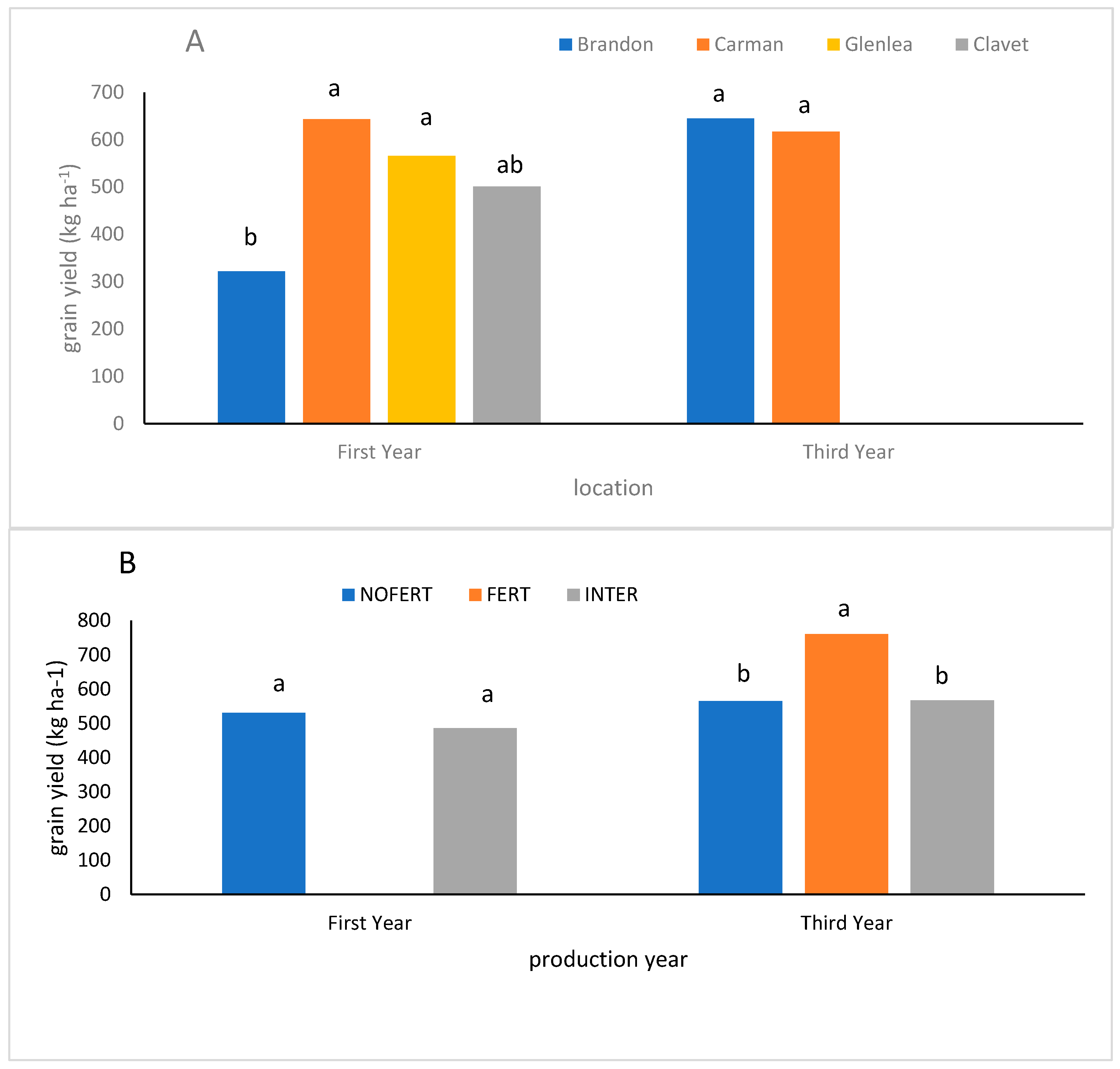
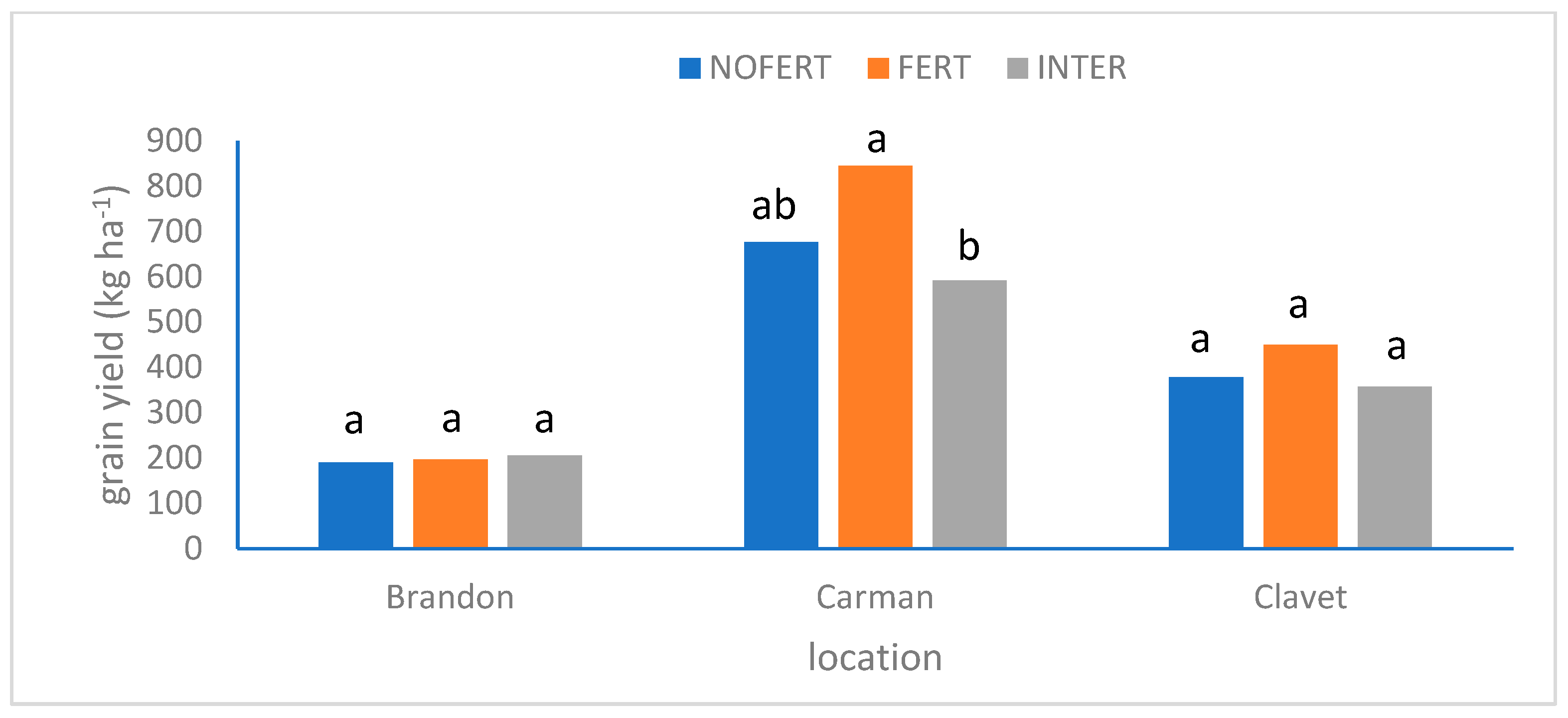
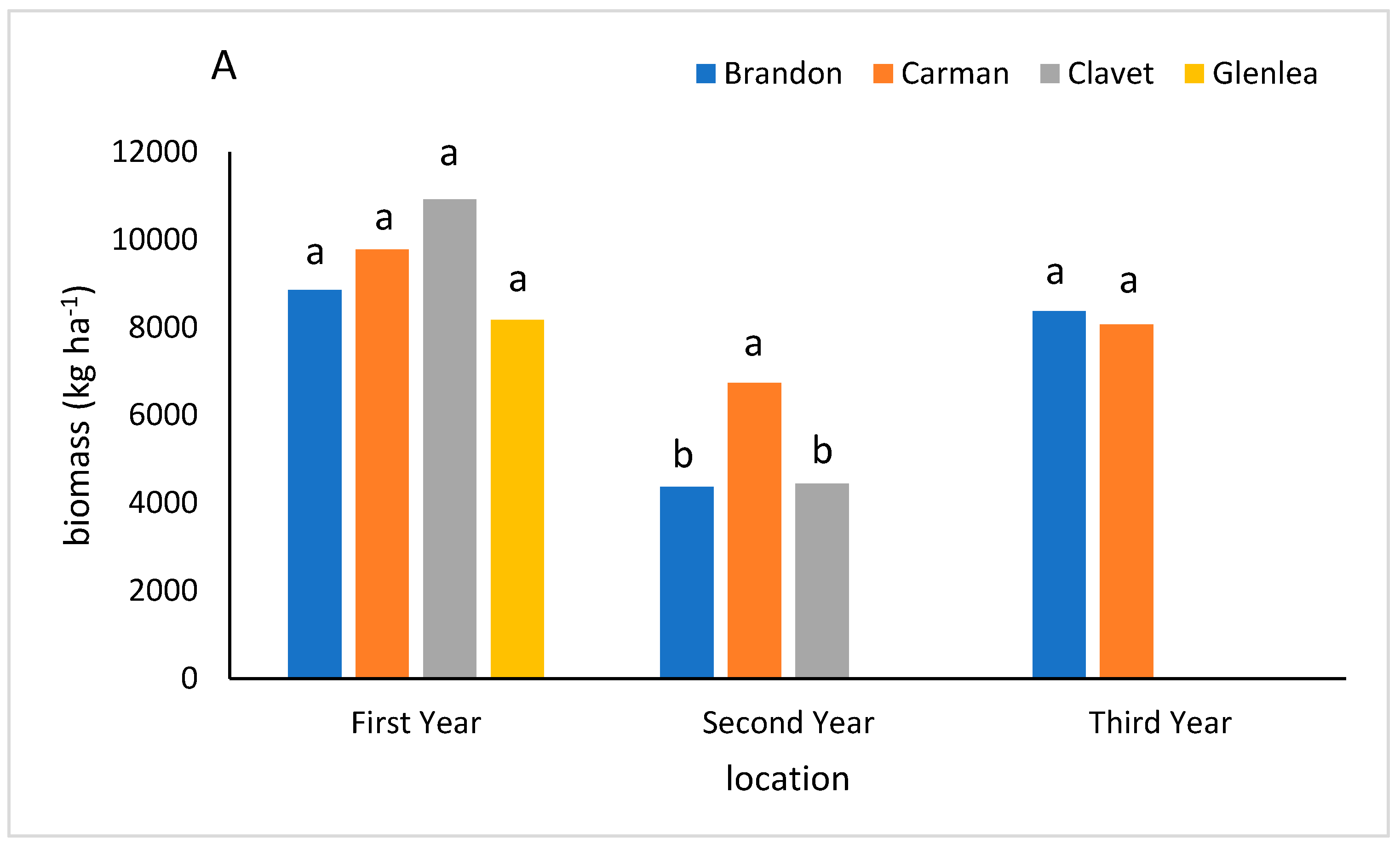

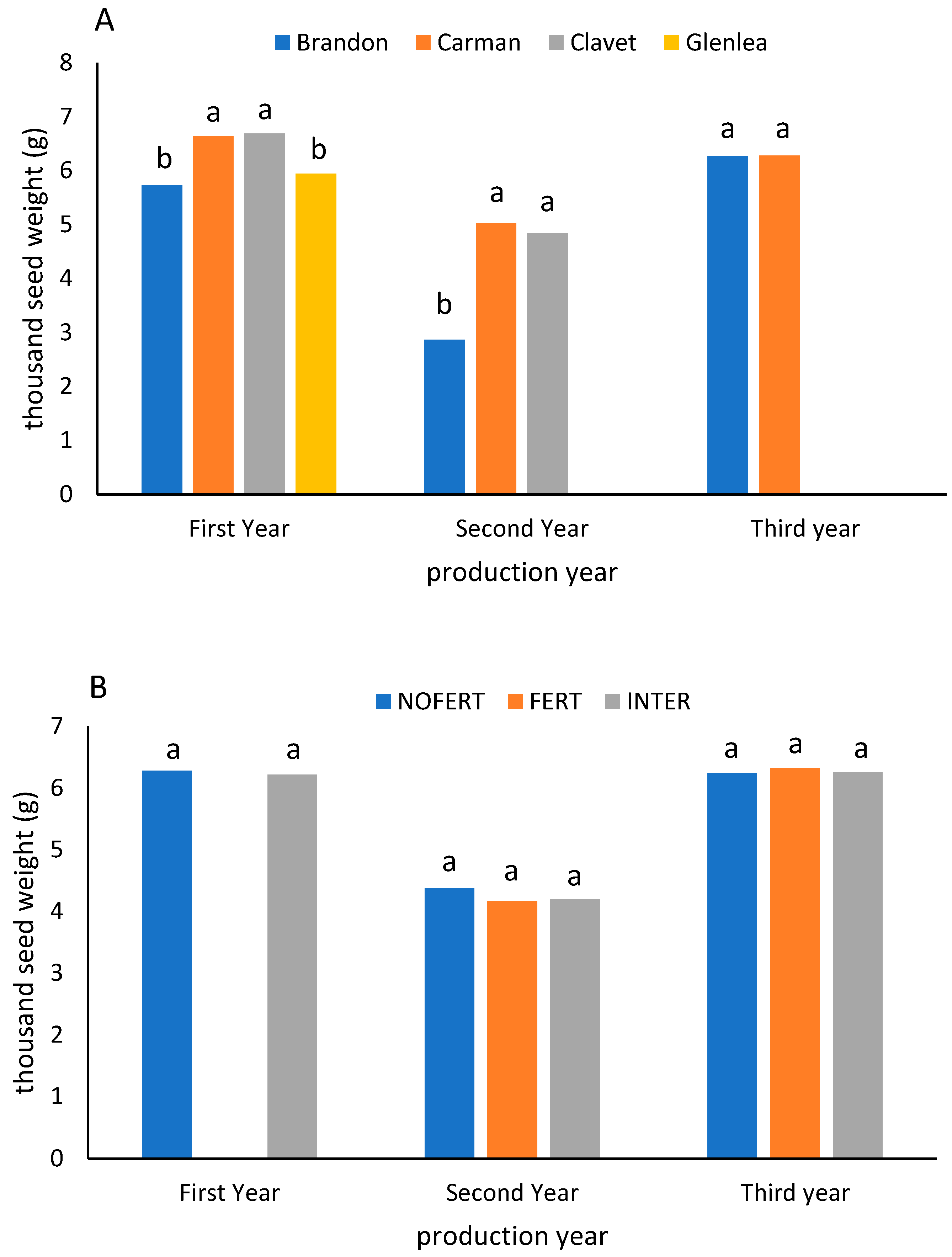
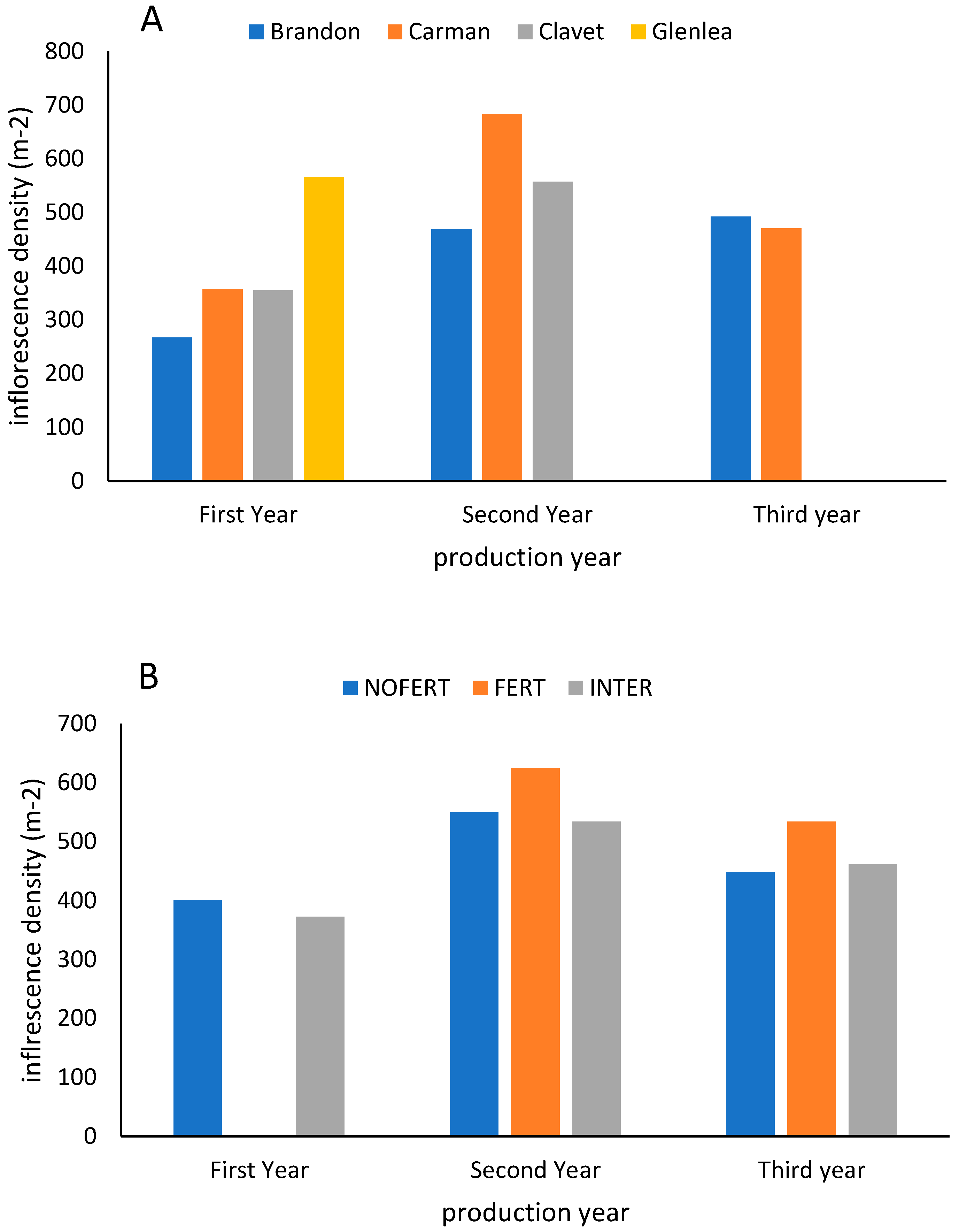
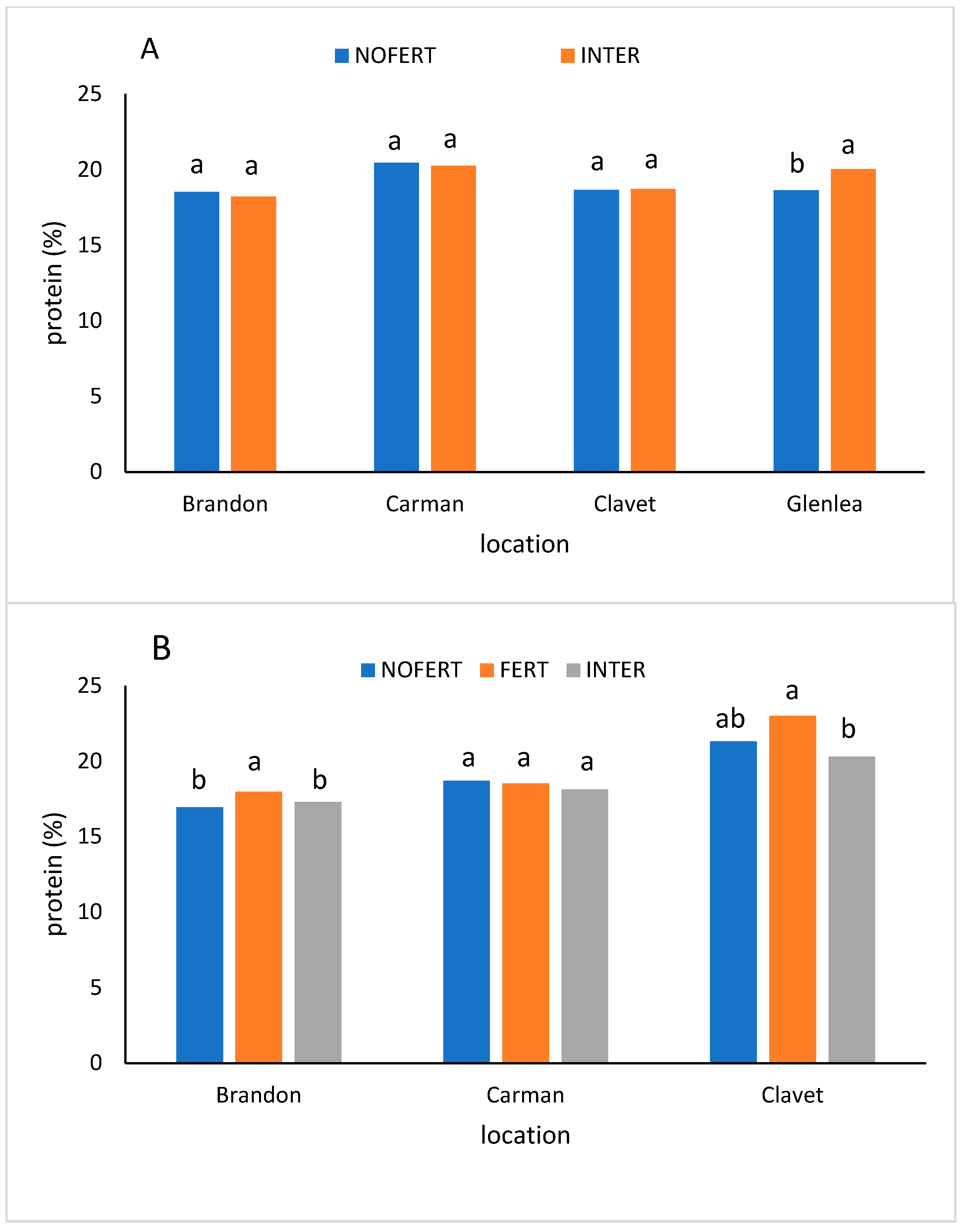

| Location | Location | Soil Factors | Seeding Date | Years in Stand | Plot Size | ||
|---|---|---|---|---|---|---|---|
| Series | Texture | Description | |||||
| Brandon * | (49.869264, 99.978605) | Wheatland | Sand | Orthic Black Chernozem | 4 May 2019 | 2019–2022 | 73 m2 |
| Carman * | (49.501523, 98.027554) | Denham | Loam | Orthic Black Chernozem | 19 July 2019 | 2019–2023 | 60 m2 |
| Clavet ** | (51.935479, 106.381302) | Bradwell | Loam | Dark Brown Chernozem | 15 May 2019 | 2019–2021 | 50 m2 |
| Glenlea * | (49.649324, 97.119810) | Scanterbury/Red River | Clay | Gleyed/Gleyed Rego Black Chernozem | 27–29 May 2020 | 2020–2021 | 1.11 ha |
| Mean Daily Temperature (°C) | Total Precipitation (mm) | |||||||||
|---|---|---|---|---|---|---|---|---|---|---|
| Month | 2019 | 2020 | 2021 | 2022 | 30 yr * | 2019 | 2020 | 2021 | 2022 | 30 yr * |
| January | −17.1 | −12.4 | −9.3 | −17.7 | −15.2 | 12.9 | 14.0 | 2.5 | 13.8 | 15.5 |
| February | −20.6 | −12.4 | −17.0 | −18.9 | −12.5 | 35.1 | 1.6 | 3.8 | 20.6 | 13.8 |
| March | −7.0 | −4.9 | 0.0 | −7.6 | −5.3 | 1.4 | 2.6 | 2.6 | 18.9 | 21.4 |
| April | 4.8 | 1.6 | 3.4 | −1.0 | 4.1 | 17.8 | 24.7 | 9.4 | 127.3 | 28.9 |
| May | 9.6 | 10.8 | 10.8 | 10.8 | 11.5 | 36.9 | 27.8 | 27.2 | 110.1 | 78.5 |
| June | 17.3 | 18.3 | 19.3 | 17.5 | 17.1 | 37.9 | 70.2 | 102.9 | 39.4 | 98.0 |
| July | 19.5 | 20.3 | 21.2 | 19.2 | 19.3 | 57.7 | 52.9 | 17.2 | 82.8 | 70.4 |
| August | 18.1 | 18.4 | 18.2 | 19.3 | 18.6 | 61.7 | 24.3 | 78.0 | 48.9 | 68.6 |
| September | 12.6 | 12.3 | 15.7 | 14.3 | 13.5 | 150.7 | 10.8 | 16.5 | 26.7 | 51.4 |
| October | 2.9 | 2.1 | 8.4 | 6.4 | 5.6 | 54.1 | 17.2 | 79.6 | 27.5 | 39.0 |
| November | −5.5 | −3.2 | −1.6 | −4.4 | −4.0 | 16.6 | 4.2 | 23.8 | 14.4 | 23.5 |
| December | −11.4 | −6.9 | −12.7 | −13.9 | −11.7 | 2.7 | 17.5 | 17.6 | 9.8 | 22.3 |
| Mean/Total | 1.9 | 3.7 | 4.7 | 2.0 | 3.4 | 485.5 | 267.8 | 381.1 | 540.2 | 531.3 |
| Mean Daily Temperate (°C) | Total Precipitation (mm) | |||||||||
|---|---|---|---|---|---|---|---|---|---|---|
| Month | 2019 | 2020 | 2021 | 2022 | 30 yr * | 2019 | 2020 | 2021 | 2022 | 30 yr * |
| January | −18.1 | −13.8 | −10.8 | −18.1 | −16.3 | 20.3 | 11.1 | 8.7 | 36.2 | 17.6 |
| February | −22.6 | −12.6 | −19.4 | −19.5 | −14.0 | 24.4 | 1.8 | 12.1 | 25.1 | 13.8 |
| March | −8.2 | −5.4 | −1.0 | −7.7 | −6.5 | 2.6 | 5.0 | 6.8 | 8.3 | 26.3 |
| April | 4.2 | 0.9 | 3.0 | −0.7 | 3.6 | 14.0 | 23.8 | 13.7 | 44.5 | 25.9 |
| May | 8.9 | 10.4 | 10.0 | 10.2 | 10.9 | 43.2 | 8.2 | 26.2 | 125.8 | 63.9 |
| June | 16.3 | 17.5 | 18.3 | 16.5 | 16.4 | 78.2 | 217.0 | 102.7 | 98.8 | 94.0 |
| July | 19.1 | 20.0 | 20.4 | 19.3 | 18.9 | 41.2 | 59.1 | 29.6 | 85.7 | 66.9 |
| August | 16.8 | 18.3 | 17.1 | 18.9 | 18.0 | 74.9 | 58.6 | 159.9 | 28.4 | 58.6 |
| September | 12.4 | 11.4 | 14.9 | 13.5 | 12.6 | 176.2 | 13.8 | 20.7 | 23.8 | 39.8 |
| October | 2.4 | 0.8 | 7.2 | 5.5 | 4.5 | 50.0 | 10.1 | 23.3 | 16.1 | 32.4 |
| November | 0.6 | −4.5 | −3.2 | −6.0 | −5.3 | 17.6 | 1.5 | 15.2 | 10.3 | 20.0 |
| December | −12.7 | −8.7 | −15.6 | −16.5 | −13.9 | 3.1 | 19.6 | 27.9 | 9.6 | 22.9 |
| Mean/Total | 1.6 | 2.9 | 3.4 | 1.3 | 2.4 | 545.7 | 429.6 | 446.8 | 512.6 | 482.1 |
| Mean Daily Temperature (°C) | Total Precipitation (mm) | |||||||
|---|---|---|---|---|---|---|---|---|
| Month | 2019 * | 2020 | 2021 | 30 yr | 2019 * | 2020 | 2021 | 30 yr |
| January | −14.1 | −13.3 | −10.7 | −13.9 | 7.2 | 24.3 | 3.0 | 9.5 |
| February | −24.2 | −10.8 | −19.3 | −15.0 | 11.1 | 3.5 | 2.3 | 6.8 |
| March | −6.1 | −6.6 | −1.2 | −6.2 | 2.7 | 30.2 | 15.2 | 10.8 |
| April | 4.8 | 0.0 | 4.5 | 3.2 | 0.4 | 27.4 | 8.5 | 18.3 |
| May | 9.7 | 11.4 | 10.6 | 11.4 | 4.4 | 47.0 | 41.2 | 39.3 |
| June | 16 | 15.3 | 18.8 | 16.2 | 84.8 | 94.6 | 39.0 | 73.9 |
| July | 17.8 | 18.8 | 21.9 | 18.8 | 67.6 | 34.6 | 8.5 | 51.3 |
| August | 15.4 | 18.6 | 17.8 | 17.6 | 20.3 | 26.5 | 42.2 | 31.2 |
| September | 12.3 | 12.3 | 13.8 | 12.9 | 39.5 | 17.1 | 23.8 | 24.3 |
| October | 0.8 | 1.4 | 5.5 | 3.9 | 11.2 | 7.7 | 6.7 | 16.8 |
| November | −5.5 | −5.7 | −3.6 | −6.6 | 13.1 | 58.5 | 10.2 | 15.7 |
| December | −12 | −9.5 | −18 | −13.3 | 4.1 | 7.3 | 9.9 | 6.7 |
| Mean/Total | 1.2 | 2.7 | 6.5 | 2.4 | 266.4 | 378.7 | 183.7 | 304.6 |
| Mean Daily Temperature (°C) | Total Precipitation (mm) | |||||
|---|---|---|---|---|---|---|
| Month | 2020 * | 2021 * | 30 yr ** | 2020 * | 2021 * | 30 yr ** |
| January | −12.4 | −10.4 | −16.4 | 7.1 | 3.6 | 19.9 |
| February | −13.1 | −17.7 | −13.2 | 0.9 | 2.9 | 13.8 |
| March | −4.8 | −0.1 | −5.8 | 3.9 | 7.3 | 24.5 |
| April | 2.0 | 3.7 | 4.4 | 15.9 | 24.8 | 30.0 |
| May | 11.0 | 11.5 | 11.6 | 11.6 | 18.3 | 56.7 |
| June | 19.2 | 20.2 | 17.0 | 49.4 | 60.6 | 90.0 |
| July | 21.1 | 22.1 | 19.7 | 43.9 | 9.6 | 79.5 |
| August | 19.3 | 19.0 | 18.8 | 88.7 | 95.1 | 77.0 |
| September | 12.3 | 16.2 | 12.7 | 20.8 | 11.8 | 45.8 |
| October | 2.1 | 9.0 | 5.0 | 11.7 | 52.6 | 37.5 |
| November | −3.3 | −2.6 | −4.9 | 3.4 | 32.7 | 25.0 |
| December | −8.2 | −13.3 | −13.2 | 16.7 | 14.2 | 21.5 |
| Mean/Total | 3.75 | 4.8 | 3.0 | 274.0 | 333.5 | 521.2 |
| Direct Effect on Yield m−2 | Direct Effect on Density m−2 | Direct Effect on Yield m−2 | Direct Effect on Density m−2 | Direct Effect on Yield m−2 | Direct Effect on Density m−2 | Direct Effect on Yield m−2 | Direct Effect on Density m−2 | |
|---|---|---|---|---|---|---|---|---|
| Brandon | Carman | Clavet | Glenlea | |||||
| First production year | ||||||||
| Density m−2 | 0.138 | 0.173 | 0.383 | 0.445 ** | ||||
| Biomass m−2 | 0.766 ** | 0.491 ** | 0.253 | 0.569 *** | ||||
| TSW | 0.059 | 0.452 ** | 0.343 * | −0.077 | 0.169 | 0.139 | 0.231 | 0.122 |
| Second production year | ||||||||
| Density m−2 | 0.292 * | 0.717 *** | 0.774 ** | |||||
| Biomass m−2 | 0.030 | 0.179 | 0.068 | |||||
| TSW | 0.813 *** | −0.215 | −0.048 | 0.142 | −0.117 | 0.315 | ||
| Third production year | ||||||||
| density m−2 | 0.312 * | 0.758 *** | ||||||
| biomass m−2 | 0.582 *** | 0.051 | ||||||
| TSW | 0.100 | 0.080 | 0.008 | 0.695 *** | ||||
Disclaimer/Publisher’s Note: The statements, opinions and data contained in all publications are solely those of the individual author(s) and contributor(s) and not of MDPI and/or the editor(s). MDPI and/or the editor(s) disclaim responsibility for any injury to people or property resulting from any ideas, methods, instructions or products referred to in the content. |
© 2023 by the authors. Licensee MDPI, Basel, Switzerland. This article is an open access article distributed under the terms and conditions of the Creative Commons Attribution (CC BY) license (https://creativecommons.org/licenses/by/4.0/).
Share and Cite
LeHeiget, P.M.; McGeough, E.J.; Biligetu, B.; Cattani, D.J. Grain Yield Potential of Intermediate Wheatgrass in Western Canada. Agriculture 2023, 13, 1924. https://doi.org/10.3390/agriculture13101924
LeHeiget PM, McGeough EJ, Biligetu B, Cattani DJ. Grain Yield Potential of Intermediate Wheatgrass in Western Canada. Agriculture. 2023; 13(10):1924. https://doi.org/10.3390/agriculture13101924
Chicago/Turabian StyleLeHeiget, Patrick M., Emma J. McGeough, Bill Biligetu, and Douglas J. Cattani. 2023. "Grain Yield Potential of Intermediate Wheatgrass in Western Canada" Agriculture 13, no. 10: 1924. https://doi.org/10.3390/agriculture13101924





